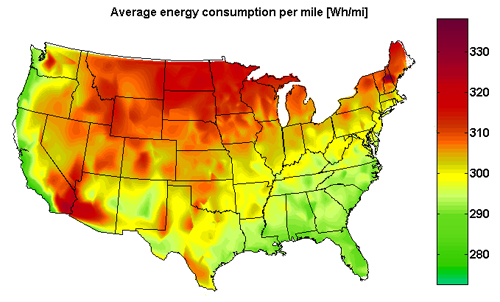Carnegie Mellon Study Shows Electric Vehicle Range and Emissions Vary With Climate
By Tara Moore / 412-268-9673
 A new study by Carnegie Mellon University researchers finds that electric vehicles have shorter range and more emissions in regions with extreme weather.
A new study by Carnegie Mellon University researchers finds that electric vehicles have shorter range and more emissions in regions with extreme weather.
Mechanical Engineering and Engineering and Public Policy Professor Jeremy Michalek and mechanical engineering graduate student Tugce Yuksel used data collected from Nissan Leaf drivers together with weather data to analyze the regional effect of air temperature on the range, energy consumption, and emissions of electric vehicles.
“We found that average electric vehicle range in some regions can drop from a rated 75 miles to just 45 miles on the hottest or coldest days of the year,” Yuksel said. “About one of every eight U.S. daily trips is longer than the vehicle’s rated range, and as much as one of every four daily trips is longer than the range observed in extreme weather.”
Electric vehicles consume more energy in extreme weather for two primary reasons, according to the study: Heating or cooling the passenger cabin drains energy from the battery, and batteries also are less efficient when cold.
“Unlike gasoline vehicles, which generate waste heat that can be used to warm the cabin, electric vehicles must consume precious battery energy to generate heat,” Yuksel said.
The study, published in the journal Environmental Science and Technology, notes that the effect is larger in some regions than others.
“Worst-day range may drop only a few miles in San Francisco, but on a cold day in Rochester, Minn., or a hot day in Phoenix, Ariz., the effect can be substantial, though these effects also vary from driver to driver,” Yuksel said.
Reduced efficiency also can increase the emissions associated with charging an electric vehicle, the study points out.
“When a vehicle is less efficient, it consumes more electricity from the power grid, and it also takes longer to charge, stretching into the night when coal-fired power plants are more likely to respond to electric vehicle demand,” Michalek said. “The West Coast has both mild weather and a cleaner electricity mix – a good place for electric vehicles. In contrast, the northern Midwest is heavy with coal, and the cold weather means more electricity is needed to charge vehicles – resulting in over three times as much carbon dioxide per mile traveled.”
The authors note that state policies for electric vehicles also vary across the U.S., which impact sales.
“Several states have adopted zero-emission vehicle, or ZEV, mandates that force major automakers to sell vehicles with no tailpipe emissions: either pure electric vehicles or fuel cell vehicles,” Michalek said. “California dominates electric vehicle sales, and selling electric vehicles in Northeastern ZEV states requires overcoming extra challenges including the reduced range and higher upstream emissions of electric vehicles there.”
The researchers also note that while their study focuses on isolating the effect of temperature, there are other factors that drive regional variation in electric vehicle benefits.
“With a cleaner electric power grid, regional differences in electric vehicle charging emissions may be reduced,” Michalek said. “But temperature will remain a source of variation in electric vehicle benefits across the U.S., and other regional factors, like driving conditions, vehicle mix, parking availability, and consumer preferences will also continue to affect the benefits, drawbacks and adoption patterns of electric vehicles.”
Read the full paper: http://pubs.acs.org/doi/abs/10.1021/es505621s.
###
The above image shows how the average energy consumption — watt-hour per mile — for electric vehicles varies depending on geographic location.